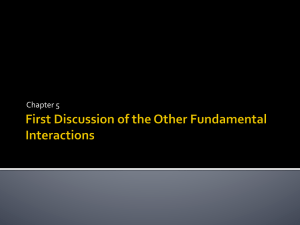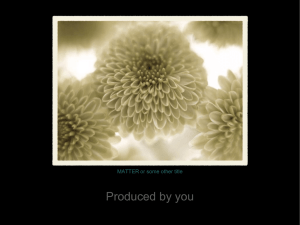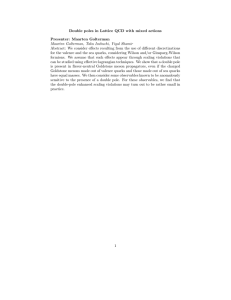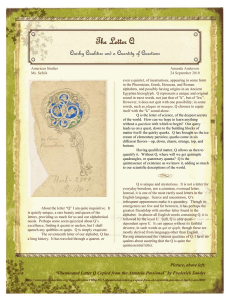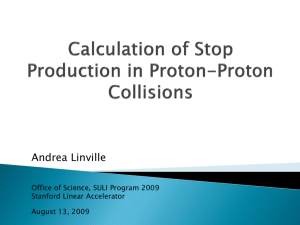Physics 214 Experimental Particle Physics Lecture 1 What to expect.
advertisement
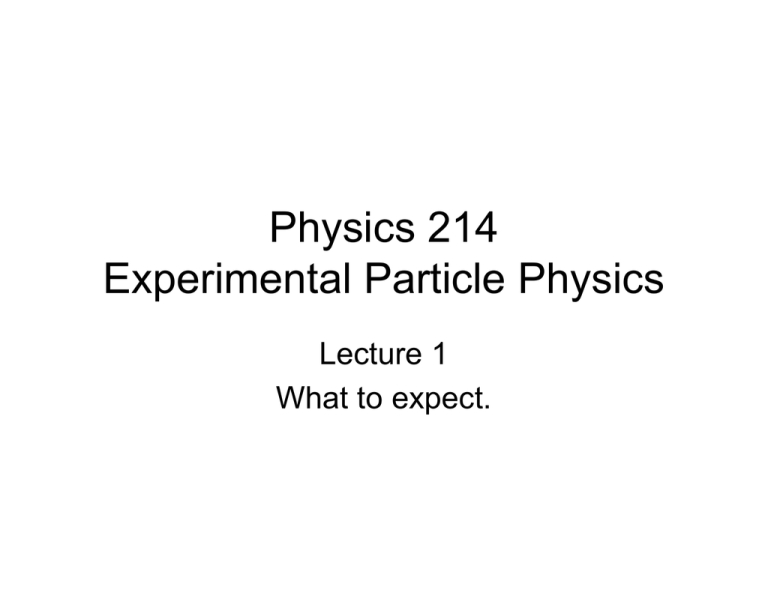
Physics 214 Experimental Particle Physics Lecture 1 What to expect. We’ll start with a grand tour. I do not expect you to understand this tour in detail. Instead, think of it as an orientation to which we’ll fill in many of the details over the next two quarters. The big picture • Standard Model of Particle Physics • Standard Model of Cosmology • My taste: – Interesting experimental questions today all revolve around these two models. – The most promising are those that key in on experimental inconsistencies between them. Will try to focus on topics that matter for your graduate and post-doc career, with a little bit of general context thrown in. The BIG Experimental Q’s • Matter content of the universe – What is dark matter? – What is dark energy? • Where did all the anti-matter go? – CP violation in the lepton sector? – New physics with CP violating couplings? • Electroweak Symmetry breaking – Does the higgs exist? And at what mass? Matter Content of the Universe I will not cover cosmology in this class! It’s covered in detail in Physics 227 at UCSD. Or read up on it in references at course web site. Observation of dark matter. • Collision of two galaxies. –Gas clouds collide, drag slows them down as they interact. • Use grav. lensing to measure mass in collission area. • Find that there is additional mass outside the drag region. – There must be mass that does not shine nor interact with the gas in the galaxy. Matter/anti-matter Asymmetry The cosmic diffuse gamma ray spectrum observed rules out the existence of equal number of matter and anti-matter domains with domain sizes smaller than the size of the visible universe. Matter-antimatter symmetry must be broken at some as yet unknown scale. Explanation Attempts • CP violation in quark sector – Well measured and insignificant compared to what’s needed. • CP violation in lepton sector – Measure sinθ13 in neutrino sector to assess experimental feasibility. – If feasible, build neutrino factory to measure CP violation in lepton sector. • New physics at higher energies. – E.g. Most general SUSY model has 44 CP violating couplings in Lagrangian, most of which enter via SUSY breaking mechanism. Standard model predicts higgs mH < 158GeV at 95% C.L. Direct searches rule out mH < 114 GeV, 160-170GeV All of MSSM requires a light Higgs (mH < 130GeV) A.Hoecker http://arxiv.org/abs/0909.0961 There are plenty of other ways for nature to implement EWK symmetry breaking, incl. more than one higgs doublet. We will discuss this in some detail next quarter. … lot’s of smaller q’s as well • Is the neutrino its own anti-particle? • The strong CP problem – Do Axions exist? • … and lot’s more that are more pedestrian in nature. … and then there’s speculation … • • • • • • Supersymmetry Extra dimensions Grand Unified Theories et al. Lepton flavor violation Proton decay Black holes made in the lab Most of this I will stay away from in this course, except susy towards the end of the second quarter. Experimental facilities coming up • Collider Physics: – 1st results from LHC ~2010, expect to run for ~20years. – Next Linear Collider not before 2020 • Neutrino physics: – 1st results on sinθ13 ~2012 – CP violation physics not before 2020 • Dedicated Dark Matter Searches – Direct searches with cryogenic detectors • Reach sensitivity where dark matter candidates possibly observed at LHC might be confirmed within the next decade. – Indirect searches via astrophysical objects • Many projects both currently running as well as planned • Dark Energy – A variety of projects with timescales from few years to more than a decade. Switch gears now … Talk a little about the mechanics of this course. http://physics.ucsd.edu/students/courses/fall2009/physics214/ Lectures • Twice a week: – Mo,Tue 2-3:20pm • Hope to have some transparencies up at the website by lunch of the day of the lecture. • Will use transparencies as guide for content, but do some of the derivations by hand. Seminars • Each student needs to give a seminar talk that accounts for 20% of the total grade. • I’m expecting a 30min talk on one of the topics listed on the website. • I’m expecting serious preparation for this, and will want to see the slides one week prior to the day they are given!!! • First Seminar date: – Tuesday October 27th Grades • 50% take home final – Most likely during week before finals week. • 30% homework – I will reuse some of the homework assignments from last year, and expect you to not look up solutions from your friends !!! – I have no grader, and thus might decide not to grade all problems on all homework assignments. • 20% seminar If you are a theorist, and don’t want to put in the effort required to get a decent grade, then please sign up pass/fail. I won’t fail anybody who does ok on the final or gives a decent seminar. Any Questions? If not, let’s get started with an introductory “fly through” Particle Physics. Elementary Particle Physics • The quest to understand matter and how it interacts. – Discover which particles are elementary – Develop theory of their interactions • What’s an elementary particle ? – Something without further constituents – Point-like Probing the size via scattering • Shine light (or some other quantum) on an object. • Your resolution depends on energy of quantum – Remember Rutherford scattering! hc hc E = h! = #"= " E hc R! E Need high energy to probe short distances! Structure of matter • • • • R ~ 10-8 cm atoms R ~ 10-12 cm nuclei R ~ 10-13 cm proton R < 10-18 cm quarks, leptons At present, we consider quarks & leptons To be point-particles and elementary. Natural Units • Energy [E] – eV, keV, MeV, GeV, TeV, PeV, … 100, 103, 106, 109, 1012, 1015 1eV = 1.6 10-19 J eV is more useful unit in particle physics than Joule for obvious reasons. • Largest energy colliders: – Tevatron ~ 2TeV CoM for proton-antiproton collision – LHC ~ 7-14TeV CoM for proton-proton collision. Natural Units (2) • Mass: E = m c2 [E] = [m] [v]2 = [m] In natural units velocity is dimensionless because Special relativity treats length and time on equal footing. [length]/[time] = dimensionless ! The only fixed, and thus natural scale is c. Accordingly, we set c=1. [length] = [time] = 1/[E] Natural Units (3) • Momentum [P] = [m] [v] = [m] = [E] • Angular momentum is dimensionless [J] = [length] [P] = [length] [E] but angular momentum is quantized with natural scale being h It is thus natural to set h = 1 ( Recall h ~ 10-34 J sec ~ 6.6 10-22 MeV/sec ) Natural Units (4) • Charge Coulomb force: F ~ Q2/L2 3 3 [length] [length] [Q] = [F][length]2 = [M ] = 2 [time] [length]3 Charge is dimensionless It’s scale is defined by the electromagnetic interaction. We’ll get back to this later. Natural Units Summary Quantity E P M length time J Q N.U. GeV GeV GeV 1/GeV 1/GeV dimensionless dimensionless Conv. Factor to SI 1GeV = 1.6 10-19J 1 kgm/s = 1.87 1018GeV 1kg = 5.61 1026GeV 1m = 5.07 1015 GeV-1 1sec = 1.52 1024 GeV-1 Some more useful facts • 1 fermi = 10-13cm = 5.07 GeV-1 • 1 fermi2 = 10 mb • 1 GeV-2 = 0.389 mb e2 1 != # 4 " 137 e = 4 "! # 0.303 Fundamental Particles • Fermions: – Spin 1/2 -> Fermi-Dirac statistics – All matter is made of fermions • Bosons: – Integer spin -> Bose-Einstein statistics – All forces are mediated via bosons • Higgs boson is special, we’ll deal with that next quarter. Forces = Interactions • Strong (QCD) – Mediated by gluons – Holds nuclei together • Electroweak – E&M mediated by photon – Weak mediated by W,Z – Electroweak symmetry breaking requires Higgs boson. • Gravity – Mediated by graviton – Beyond the scope of this course Photon, gluon, W, Z all spin=1 Higgs is spin=0 Graviton is spin=2 Photon, gluon,graviton m=0 W,Z,Higgs roughly 100GeV EKW symmetry breaking explains why EWK bosons have such different masses. Matter comes in 2 types • Leptons: – EWK & gravity • Quarks: – EWK & gravity & strong Both types come in 3 families (or flavors) of doublets. Charged particles couple to photon, W, Z Neutral particles couple only to W,Z Quarks are bound into hadrons • Strong force increase with distance, thus making it impossible to have free quarks. • The “charge” of the strong force is called color because it’s a triplet. – Color neutrality can be achieved either via • • • • color-anticolor pair Color triplet with one of each color Anticolor triplet with one of each color More exotic things are in principle possible, but have yet to be confirmed conclusively to exist. Quark Model • At this point it should be obvious that you can construct a large variety of baryons and mesons simply by angular momentum addition. • All of them will be color neutral. • Lowest lying states for a given flavor composition are stable with regard to strong interaction but not weak interaction. • Excited states can be made by adding orbital angular momentum of the quarks with respect to each other. • Excited states are not stable with respect to strong interactions. However, nature’s more complicated still. u u d “Valence” quarks in proton are “glued together” via gluon exchange. However, nature’s more complicated still. q u u q d The quarks from quantum fluctuations are called see quarks. You can probe see quarks and gluons inside hadrons by scattering electrons off hadrons at high momentum transfer. Interactions mediated by vector bosons lW- ν via emission of W that decays to lepton + neutrino c Charm decay d to down quark Mass of W >> mass of c quark Tempting to think about the “exchange” as a quantum fluctuation. Range of “force” as quantum fluctuation !E!t " h !E = mc 2 h R " c!t = mc h ! "t # 2 mc R ∝1/m Range of force is inverse proportional to mass of mediator. Well, I’m cheating a little • We will see that this works because: – – – – Cross section ∝|A|2 A is perturbative expansion in Feynman diagrams. Diagrams include vertex factors and propagators. Propagators are interpreted as “mediators” of the interaction. • If you wish, the mental picture works because perturbation theory works. Perturbation Cartoon A= e - A1 + e ! - A2 e - ! ! e - ! + … e - ! e - ! e - e - ! e - ! e - As α ≈ 1/137 << 1, the mental picture works.
